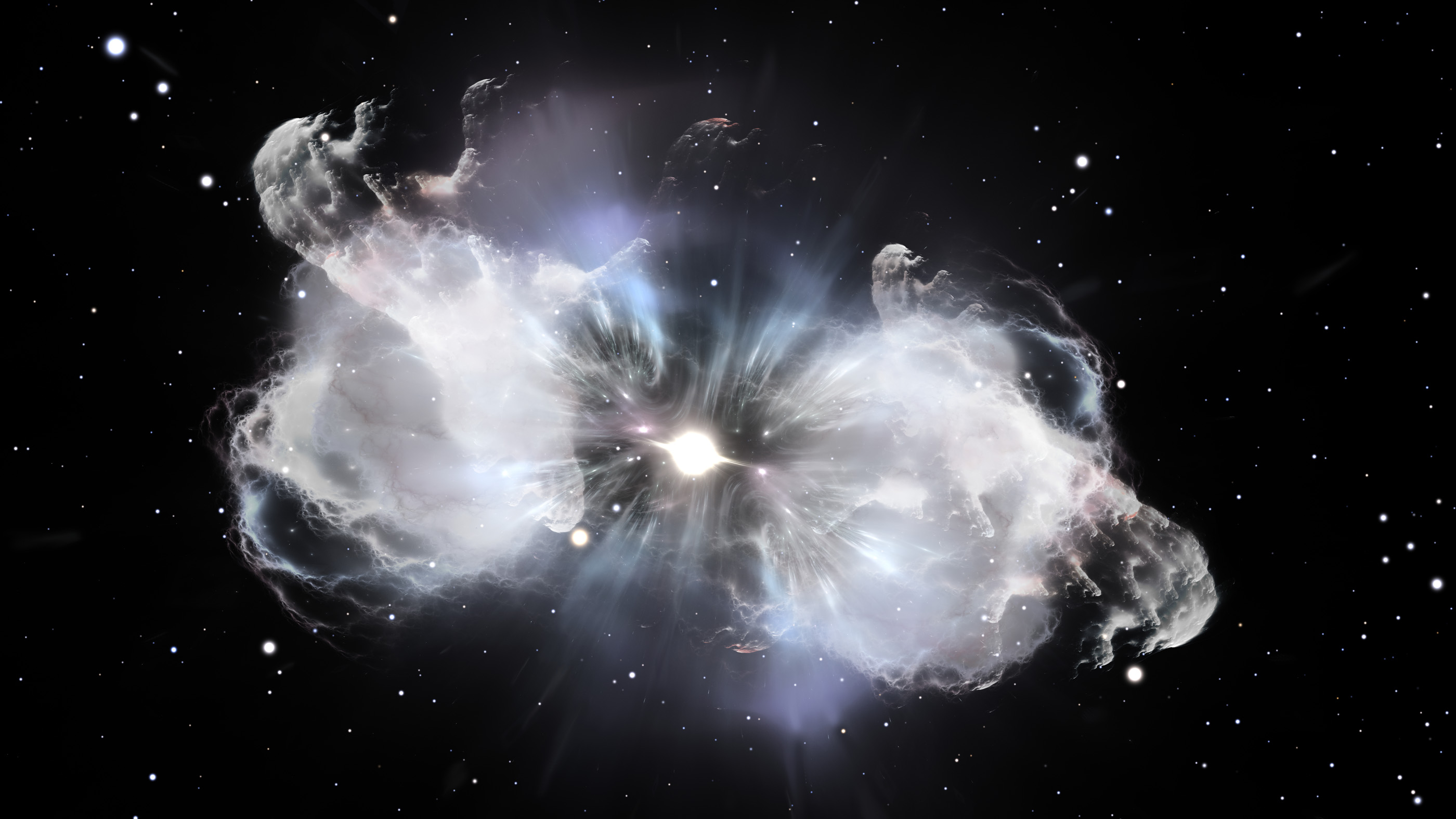Runaway star caught streaking across Milky Way at 2 million mph ... in the wrong direction
In 2017, astronomers noticed a star streaking out of the Milky Way at nearly 2 million mph (3.2 million km/h) — roughly four times faster than our sun orbits — and flying against the direction in which most stars trek around the galactic center. It's also made of completely different star stuff, mostly heavy, "metallic" atoms rather than the usual light elements. LP 40-365, as it was called, was as eye-catching as a wooden car barreling up the interstate against traffic at hundreds of miles per hour.
"It is exceptionally weird in a lot of different ways," said study lead author J.J. Hermes, an astronomer at Boston University.
Related: The 12 strangest objects in the universe
The star moves so quickly that it's headed out of our galaxy for good, which astronomers have taken as evidence that the metallic explorer was launched here by a cosmic catastrophe — a supernova. But they couldn't tell how the supernova had sent it flying. Was LP 40-365 a piece of the exploded star itself? Or was it a partner star flung clear by the shockwave associated with star explosions? A new analysis of old data finds that the star — called a white dwarf — spins about its axis at a leisurely pace — a hint that it is indeed a piece of stellar debris (not a partner star) that managed to survive one of the galaxy's most violent and mysterious events.
"We can now connect this star to the shrapnel from an exploded white dwarf with a lot more confidence," said Hermes.
Witness to a cosmic catastrophe
Shortly after discovery, astronomers realized that the white dwarf star's unique features likely meant that it had witnessed a supernova firsthand. It was fast, and its entire makeup appeared altered.. Most stars are made almost entirely of hydrogen and helium. In LP 40-365, however, astronomers detected only heavy elements like oxygen, neon and magnesium — atoms fused in a supernova furnace. A supernova had infused the entire star with these "metals." (Unlike chemists, astronomers consider any element heavier than helium to be a metal.)
Astronomers concluded that the star had once been a member of a pair of white dwarfs — the typical fate of small sun-like stars — which explode after siphoning off enough mass from their partner. These explosions are so powerful that elements fuse their nuclei into completely new elements. Two scenarios were possible. In the first, one star exploded cleanly, blasting its partner with heavy metals and sending it careening out into space. In the second, some shard of the exploding star escaped the supernova, laden with the metals forged in the explosion.
Get the world’s most fascinating discoveries delivered straight to your inbox.
"One big question is: Which part of the binary star are we observing," Saurabh Jha, an astronomer at Rutgers University in New Jersey, who was not involved in the research, told Live Science in an email. "Both are exciting, giving us a new way to understand exploding white dwarfs."
A slowly spinning survivor
To better understand the bizarre star, Hermes and colleagues sifted through data collected by NASA's Transiting Exoplanet Survey Satellite, which looks for distant planets that pass in front of and dim their host stars. LP 40-365 doesn't have a planet, but it does dim and brighten every 8.9 hours, TESS data revealed. The team found the same clockwork flickering in existing data from the Hubble Space Telescope, which they believe means the star spins, bringing sunspots into and out of view. The blinking could also indicate pulsation, but stellar pulsations tend to be irregular. "The most likely scenario," Hermes said, is "that there are some little warts on the surface."
They published their findings online June 7 in The Astrophysical Journal Letters.
Knowing how fast LP 40-365 spins is useful because it helps researchers understand what the white dwarf probably experienced roughly 5 million years ago during the supernova. The pair initially orbited each other once every 30 to 60 minutes, the group estimated. If LP 40-365 were the companion star, tossed clear, it should still be whirling around nearly as quickly.
But its comparatively relaxed rotation suggests that it underwent a more dramatic transformation. The white dwarf that exploded would have puffed up more, its rotation rate plummeting much as a figure skater's spin slows when they extend their arms. The rotation period lasting more than a week suggests that the white dwarf is a diffuse fragment of the star that exploded.
Related: 15 unforgettable images of stars
"I find this a very nice piece of observational work, and assuming their calculations are correct for the predictions of the two scenarios, it certainly bolsters the case for the [incomplete supernova] scenario," Jha wrote.
The calculation assumes that the star has essentially held itself together, without spinning off too many major chunks that could significantly affect its revolution. (If a figure skater tosses off one of their skates, that could tweak their spin.)
While astronomers frequently observe white dwarf supernovas, using them to clock the accelerating expansion of the universe due to dark energy, researchers don't fully understand how such events play out. Until recently, few theorists would have predicted surviving a supernova to be possible. An off-center ignition may not detonate the entire star, but the debate is far from settled. "There's a lot of unknown physics," Hermes said.
Hunting for more "partly burnt" stars
Finding LP 40-365 to be a supernova survivor is the scenario researchers were hoping for, because it means that, compared with the companion star, the fragment is more intimately tied to the stellar catastrophe. By studying the amount of magnesium, neon and other elements inside the speedy star, the researchers could get a glimpse inside the black box of the supernova itself. "We just can't simulate that on Earth. The conditions are just so extreme that this is the only laboratory we have, finding stars like this," Hermes said.
LP 40-365 is one of a handful of fast-moving, extremely metallic white dwarfs astronomers have recently spotted, the flagship member of a group they are calling "partly burnt runaway stellar remnants.". Collecting data on more stars that supernovas have failed to burn thoroughly could help researchers get a better idea of what these systems are doing before the explosive flashes appear in astronomers' telescopes.
"This star really went out with a bang," Hermes said. "We get to use it to learn something more about these violent ends."
Originally published on Live Science.

Charlie Wood is a staff writer at Quanta Magazine, where he covers physics both on and off the planet. In addition to Live Science, his work has also appeared in Popular Science, Scientific American, The Christian Science Monitor, and other publications. Previously, he taught physics and English in Mozambique and Japan, and he holds an undergraduate degree in physics from Brown University.



